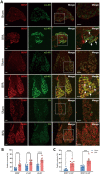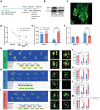Peripheral BDNF Regulates Somatosensory-Sympathetic Coupling in Brachial Plexus Avulsion-Induced Neuropathic Pain
- PMID: 37335428
- PMCID: PMC10661543
- DOI: 10.1007/s12264-023-01075-0
Peripheral BDNF Regulates Somatosensory-Sympathetic Coupling in Brachial Plexus Avulsion-Induced Neuropathic Pain
Abstract
Brachial plexus avulsion (BPA) is a combined injury involving the central and peripheral nervous systems. Patients with BPA often experience severe neuropathic pain (NP) in the affected limb. NP is insensitive to the existing treatments, which makes it a challenge to researchers and clinicians. Accumulated evidence shows that a BPA-induced pain state is often accompanied by sympathetic nervous dysfunction, which suggests that the excitation state of the sympathetic nervous system is correlated with the existence of NP. However, the mechanism of how somatosensory neural crosstalk with the sympathetic nerve at the peripheral level remains unclear. In this study, through using a novel BPA C7 root avulsion mouse model, we found that the expression of BDNF and its receptor TrκB in the DRGs of the BPA mice increased, and the markers of sympathetic nervous system activity including α1 and α2 adrenergic receptors (α1-AR and α2-AR) also increased after BPA. The phenomenon of superexcitation of the sympathetic nervous system, including hypothermia and edema of the affected extremity, was also observed in BPA mice by using CatWalk gait analysis, an infrared thermometer, and an edema evaluation. Genetic knockdown of BDNF in DRGs not only reversed the mechanical allodynia but also alleviated the hypothermia and edema of the affected extremity in BPA mice. Further, intraperitoneal injection of adrenergic receptor inhibitors decreased neuronal excitability in patch clamp recording and reversed the mechanical allodynia of BPA mice. In another branch experiment, we also found the elevated expression of BDNF, TrκB, TH, α1-AR, and α2-AR in DRG tissues from BPA patients compared with normal human DRGs through western blot and immunohistochemistry. Our results revealed that peripheral BDNF is a key molecule in the regulation of somatosensory-sympathetic coupling in BPA-induced NP. This study also opens a novel analgesic target (BDNF) in the treatment of this pain with fewer complications, which has great potential for clinical transformation.
Keywords: Brachial plexus avulsion; Brain-derived neurotrophic factor; Mechanical allodynia; Neuropathic pain; Peripheral sensitization; Sympathetic nervous system.
© 2023. Center for Excellence in Brain Science and Intelligence Technology, Chinese Academy of Sciences.
Conflict of interest statement
All authors declare that there are no conflicts of interest.
Figures









Similar articles
-
Nociceptor-localized KCC2 suppresses brachial plexus avulsion-induced neuropathic pain and related central sensitization.Cell Biosci. 2025 Jan 31;15(1):12. doi: 10.1186/s13578-025-01354-5. Cell Biosci. 2025. PMID: 39891150 Free PMC article.
-
Involvement of the BDNF-TrkB-KCC2 pathway in neuropathic pain after brachial plexus avulsion.Brain Behav. 2022 Mar;12(3):e2464. doi: 10.1002/brb3.2464. Epub 2022 Feb 1. Brain Behav. 2022. PMID: 35106976 Free PMC article.
-
5-HT3a receptor contributes to neuropathic pain by regulating central sensitization in a rat with brachial plexus avulsion.Physiol Behav. 2024 Apr 1;277:114503. doi: 10.1016/j.physbeh.2024.114503. Epub 2024 Feb 23. Physiol Behav. 2024. PMID: 38403260
-
Comparison of Different In Vivo Animal Models of Brachial Plexus Avulsion and Its Application in Pain Study.Neural Plast. 2020 Nov 12;2020:8875915. doi: 10.1155/2020/8875915. eCollection 2020. Neural Plast. 2020. PMID: 33273909 Free PMC article. Review.
-
Neuropathic pain after brachial plexus avulsion--central and peripheral mechanisms.BMC Neurol. 2015 May 4;15:73. doi: 10.1186/s12883-015-0329-x. BMC Neurol. 2015. PMID: 25935556 Free PMC article. Review.
Cited by
-
Advances in the pathological mechanisms and clinical treatments of chronic visceral pain.Mol Pain. 2024 Jan-Dec;20:17448069241305942. doi: 10.1177/17448069241305942. Mol Pain. 2024. PMID: 39673493 Free PMC article. Review.
-
Curcumin Promotes the Recovery of Motor Function After Brachial Plexus Avulsion Injury in Rats.Brain Behav. 2025 Aug;15(8):e70728. doi: 10.1002/brb3.70728. Brain Behav. 2025. PMID: 40760806 Free PMC article.
-
Sprouting sympathetic fibres release CXCL16 and norepinephrine to synergistically mediate sensory neuronal hyperexcitability in a rodent model of neuropathic pain.Br J Anaesth. 2025 Mar;134(3):804-816. doi: 10.1016/j.bja.2024.10.019. Epub 2025 Jan 22. Br J Anaesth. 2025. PMID: 39848871 Free PMC article.
-
Nociceptor-localized KCC2 suppresses brachial plexus avulsion-induced neuropathic pain and related central sensitization.Cell Biosci. 2025 Jan 31;15(1):12. doi: 10.1186/s13578-025-01354-5. Cell Biosci. 2025. PMID: 39891150 Free PMC article.
-
Mecp2 Deficiency in Peripheral Sensory Neuron Improves Cognitive Function by Enhancing Hippocampal Dendritic Spine Densities in Mice.Cells. 2024 Jun 6;13(11):988. doi: 10.3390/cells13110988. Cells. 2024. PMID: 38891120 Free PMC article.
References
-
- Noland SS, Bishop AT, Spinner RJ, Shin AY. Adult traumatic brachial plexus injuries. J Am Acad Orthop Surg. 2019;27:705–716. - PubMed
-
- Rodrigues-Filho R, Santos AR, Bertelli JA, Calixto JB. Avulsion injury of the rat brachial plexus triggers hyperalgesia and allodynia in the hindpaws: A new model for the study of neuropathic pain. Brain Res. 2003;982:186–194. - PubMed
-
- Le W, Liu Y, Zhou Y, Lao J, Zhao X. A new rat model of neuropathic pain: Complete brachial plexus avulsion. Neurosci Lett. 2015;589:52–56. - PubMed
-
- Pace MC, Passavanti MB, De Nardis L, Bosco F, Sansone P, Pota V, et al. Nociceptor plasticity: A closer look. J Cell Physiol. 2018;233:2824–2838. - PubMed
MeSH terms
Substances
LinkOut - more resources
Full Text Sources
Medical
Research Materials
Miscellaneous

